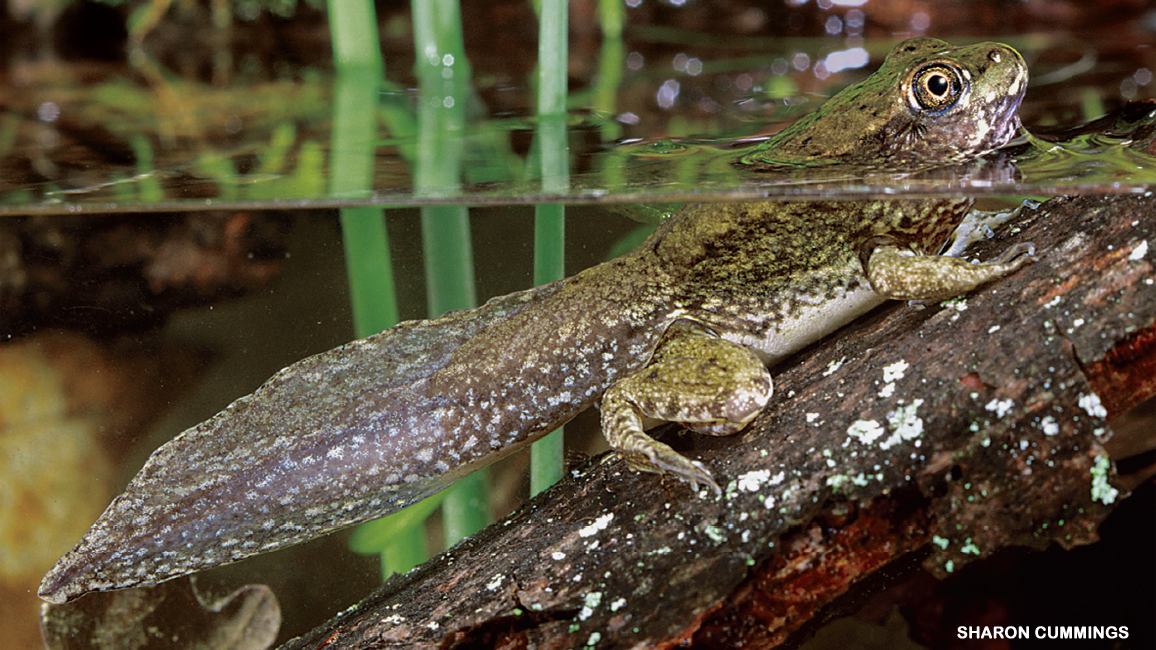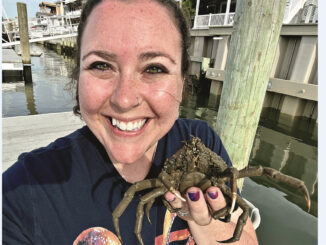
Skin
By Kate HofmannSlimy or scaly, smooth or rough, soft or tough…skin is sensational!

Imagine you could pick out a new skin as if you were shopping for clothes. What would you choose? A wrinkly rhino hide? An armadillo’s armored outfit? A colorful chameleon costume?
Animal skin comes in an amazing variety of colors, patterns, and textures, as you can see above. It might be fun to swap for a day, but your very own skin is just right for you. All these other kinds of skin are just right for the animals in them, too!
WHO WEARS SKIN?
All animals have some kind of body covering, but only vertebrates (animals with backbones) have skin. For example, amphibians (such as frogs and salamanders) have smooth skin covered with a layer of slimy stuff called mucus (MYOO-kuss). You don’t see the skin of many other vertebrates because another covering grows out of it. Mammals grow hair, birds grow feathers, and reptiles and fish grow scales.
SUPER SURVIVAL SUIT
An astronaut wears a spacesuit to survive in outer space. Skin is a survival suit for right here on Earth. Just think of all the amazing things skin does! It stands guard against harmful things from outside the body, such as dirt, germs, and the sun’s strong rays. It keeps water out when it rains or during a swim. It also holds water in, so the body doesn’t dry out and shrivel up like a prune.
Year after year, skin holds up to all kinds of wear and tear. If it does get cut, scratched, scraped, or burned, most of the time it heals up as good as new. (Even the toughest pair of jeans can’t do that!) But skin is also extremely sensitive. All day long, nerves in the skin are sensing the world. They carry warnings to the brain if there’s danger. Touch something hot or sharp, and those nerves will send an instant message—ow!
WITHIN THE SKIN
Skin has three layers, and each one has a different job to do. The epidermis (eh-puh-DUR-muss) is the thin, waterproof top layer that guards against harm from outside. Any other covering—hair, feathers, or scales—extends above this. Below it is the dermis (DUR-muss), a thicker layer that’s full of blood vessels and nerves. Under the dermis is a fatty layer that keeps the body warm and acts as a “shock absorber” to protect what’s under it.

SKIN THAT PLAYS DEFENSE
FULL-BODY ARMOR
Protection is one of skin’s most important jobs. In some animals, this job is taken very seriously. Check out the suit of armor on the hairy armadillo above. The skin across its back is hardened into bony plates. The skin between the plates is flexible, which allows the armadillo to bend and move. The result: This creature is no easy meal for predators such as jaguars or foxes that might think about eating it!
FAST FACT: To keep skin in tiptop shape, all animals shed and grow new skin. A mammal constantly sheds tiny skin flakes. A lizard loses skin in patches. A snake, though, sheds its whole skin at once.
PATTERN MATCH
Using armor isn’t the only way to play defense. The peacock flounder changes its skin’s color and pattern to match its seafloor home (left). The flounder lies flat on the bottom, keeping an eye out for passing meals. Meanwhile, bigger fish and other hungry predators swim right on by. Just how good is this fish at blending in? Well, in one science experiment, the flounder matched the pattern of a checkerboard!
TRICKY SKIN
Here’s another animal whose skin plays defense: the thorny devil from Australia. First of all, see the lizard’s scary spikes? They make a predator think twice about taking a bite. As if that weren’t enough, the lizard’s skin can also change color. Blending in with the desert sand is an even better way to avoid predators. The thorny devil also puts its tricky skin to work in another way. There are tiny grooves between the scales all over its body. These grooves catch dew and raindrops and send the water running straight into the lizard’s mouth!

SKIN THAT’S THIN
SEE-THROUGH SKIN
For frogs, thin skin is in. Check out the glass frog above. The skin on its belly is not only very thin, it’s also colorless. You can see right through it! This may help the frog blend in with the leaves of its tropical rainforest home.
SKIN THAT BREATHES
Amphibians lead double lives—part in the water and part on land. The green frog above is changing from a tadpole into an adult. As a tadpole, it breathed underwater through gills. Now it breathes air through lungs. But a frog doesn’t get all the oxygen it needs in either of these ways. It takes in the rest right through its thin skin. And can you guess how a frog drinks? Not with its mouth as you do—but through its skin. Imagine having to take a dip every time you wanted to take a sip!
FAST FACT: Many frogs live in or near water. But the waterholding frog lives in the desert. How does it stay wet? First it burrows into the ground. Then it sheds layers and layers of skin to make a waterproof cocoon. Inside, it stays moist until the rains fall.
SKIN THAT COOLS
WRINKLES TO THE RESCUE
Ever wonder why elephants (above) have such wrinkly skin? These big animals live in hot places. And unlike you, they can’t sweat to cool their skin. So they often take baths or cover themselves with mud to cool off. That’s where the wrinkles come in. Moisture stays in the cracks and folds longer than it would on smooth skin. And that keeps the animals cooler for longer. Another way elephants cool off is by fanning their ears. These enormous flaps of skin are loaded with blood vessels. Heat from the blood travels out of the elephant’s body and into the air. Now that’s cool!
FAST FACT: Among land animals, elephants, rhinoceroses, and hippos have the thickest skin. It can be up to an inch thick. That’s why they’re all part of a group called pachyderms (PAK-ihdurmz), which means “thick skin.”

SKIN THAT TALKS
SHADE SHIFTER
Sometimes skin has something to say. The panther chameleon above has skin that changes color to match its moods. When calm, it is a cool shade of green. But an enemy or other danger can bring on the bold bands of yellow, red, and turquoise you see here. And when a male wants to attract a female, his colors become flashy and bright. The female’s colors then change to tell him if she’s interested—and if she “says” no, he soon fades back to his normal shade.
WARNING SIGN
Colorful skin can attract a mate, but it can also keep predators away. That’s exactly what the fire-bellied newt is counting on. Its red belly is a threat: “Try to make a meal of me, and you’ll be seriously sorry!” If the newt is attacked, poison oozes from its skin. The next time that attacker sees a red belly, it will get the message, loud and clear!
FAST FACT:
Many people think chameleons change color to blend in with what’s around them. But that’s not true. Their colors change to reflect their mood or temperature.
As a skin-wearer yourself, you’ll surely agree: Skin is simply sensational!
















